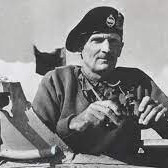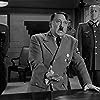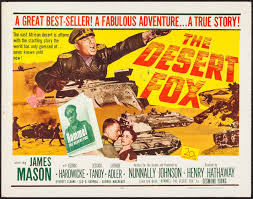There is only a short introduction to this section as it is hopefully self-explanatory. This is the first part of two parts with The Erwin Rommel film The Desert Fox (based on the book, Rommel: The Desert Fox by Brigadier Desmond Young) being the first and The Enemy Below being the second.
Anomalies
There are two distinct themes developed in the first selection of films. The first is that even when a film’s main characters are German, as in The 49th Parallel, they are never treated as heroes while their Allied counterparts are always so represented.
The second is that the films generally portray only the glorious aspects of war in the need to stand up to German tyranny. In this way, they are decidedly pro-war. The following two films are therefore notable because they diverge from these two themes. 1951’s Desert Fox attempts to portray a German as a hero, while 1957’s The Enemy Below takes a significant anti-war stance.
The Desert Fox 1951
The Desert Fox, the nickname for Field Marshall Erwin Rommel is a film which portrays Rommel (James Mason) as a hero. The film follows the period of his life in the North African desert just before his first major defeat at El Alamein in 1942 through to his death. At El Alamein, Montgomery’s Desert Rats defeated Rommel’s previously formidable Africa Corps. His absence at the end of the battle due to illness, however, enables him to preserve his reputation.
The film follows the period of his life in the North African desert just before his first major defeat at El Alamein in 1942 through to his death. At El Alamein, Montgomery’s Desert Rats defeated Rommel’s previously formidable Africa Corps. His absence at the end of the battle due to illness, however, enables him to preserve his reputation.
Rommel is finding it increasingly difficult to command his troops in a militarily sensible way because Hitler is exerting ever more personal control over battles; this problem is exacerbated as Hitler becomes more and more irrational. Then in July 1944, he was implicated with those who attempted to kill Hitler in the July Bomb Plot. Rommel is charged with treason. Honourable to the end, he agrees to sacrifice his life so that the lives of his wife and son would be spared, an option not given to other conspirators in the plot.
The Man, The Myth
Unlike, 49th Parallel, where the German characters are represented as the epitome of Nazi evil, the character of Rommel in The Desert Fox is treated more favourably. The film portrays how he is widely respected by the Allies he fought, a fact re-iterated by the film’s narrator, Lieutenant Colonel Young (as himself) when he sees Rommel for the first time after his capture:
“Already a legend in the desert. He was a fox who has chased his hunters back and forth across North Africa as often as they had chased him; his tricks and turns had made even the Tommies chuckle, which is scarcely the proper reflex to the enemy in time of war. Despite which, he was still of course my enemy. The enemy, not only of my country and the army in which I served but of all life as I knew it. Not only of democracy as free men had fashioned it, but civilization itself.”
The film shows Rommel adhering to the rules of war, which were often ignored by his compatriots, this fact created a grudging respect among his enemies that remained until his death, though he was tainted by the regime in which he served.
He is not treated as a hero in this film but as a human character rather than the typical war-loving, cruel Nazi monster. He is also depicted as a loving husband and father bound by duty through his position as a German officer forcing him to follow his country’s leadership whatever their political persuasion because, as he says, he is, “a soldier, not a politician.”
To lessen his hero status, the film only mentions his previous victories fleetingly while focusing on his defeat by Montgomery in October 1942, which begins a chain of defeats culminating in his inability to stop the Allies on D-Day. 
It’s not all new
His subsequent execution for a crime he did not commit continues a trend begun in earlier war films where German characters, no matter how sympathetically treated, ultimately end up being killed or defeated.
In order to maintain the sympathetic treatment of Rommel’s character, this film has represented him as a character increasingly disillusioned with Hitler. He is convinced that the ridiculous orders he receives from Berlin are not from Hitler but from the men that surround him. In this way, he constantly defends orders such as fighting to the last man, for example:
“I know it’s not him I tell you, it’s those…it’s those hoodlums again. Those thieves and crooks and murderers. Those…those toy soldiers, those dummy generals with those books and charts and pointers. How can he listen to those non-entities? How can he even stand to be in the smell of such filth? Why doesn’t he slaughter the lot of them and use his own intelligence?”
This disillusionment is made complete when Rommel meets Hitler at his headquarters and sees the gesticulating, raving character that appears in numerous 1940s newsreels. He does nothing more than insult Rommel.

Though the film attempts a different approach to the other films of the period, other factors place it within this period. One such factor is the unrealistic choreographed movements of the shot commandos as they attempt to assassinate Rommel at the beginning of the film. This lack of realism is exaggerated by English accents and phraseology that German characters adopt throughout the film such as when Field Marshall Rundstedt addresses Rommel as “Dear chap.”
In most cases, the action is either viewed from afar, such as bombs being dropped from high altitude or is only alluded to in the film. Again, it should be noted that the plight of the common soldier is ignored because the film is exclusively dealing with the Field Marshall. This film remains significant because it is the first film to deal with a German officer in the lead role, something not repeated since.
What’s next?
The second part of this section, on The Enemy Below will be winging its way to you soon, then we’ll be moving on to films after 1970. Happy reading folks and all comments will be welcomed.
